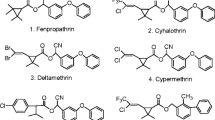Abstract
Antisera to 2,4-dichlorophenoxyacetic acid (2,4-D), a widely used herbicide, have been obtained from rabbits following immunization with various 2,4-D-protein conjugates. Employing [125I] 2,4-D-tyramine as the radioligand for the antisera, very poor assay sensitivity was achieved because of a much higher affinity of the antibodies to the tracer. When using [6-3H] 2,4-D(specific radioactivity 465 GBq/mmol) a sensitive and specific radioimmunoassay (RIA) for 2,4-D could be developed, which allows determination directly in water, plasma and urine samples. Levels as low as approximately 100 pg (450 femtomoles) of 2,4-D can be detected. The antiserum is fairly specific for 2,4-D. Other related phenoxycarboxylic acids and dichlorophenol showed a cross-reactivity smaller than 10%. After a single administration of 2,4-D (0.91 mg/100 g body weight, orally) to rats, plasma and urine levels were determined at different times. Results correspond to those found in the literature, thus indicating the utility of the RIA. Further applications and limitations are discussed.
Similar content being viewed by others
References
Albro PW, Luster MI, Chae K, Chaudhary SK, Clark G, Lawson LD, Corbett JT, Mac Kinney JD (1979) A radioimmunoassay for chlorinated dibenzo-p-dioxins. Toxicol Appl Pharmacol 50: 137–146
Arbeitsgruppe Toxikologie der Kommission für Pflanzenschutz-, Pflanzenbehandlungs- und Vorratsschutzmittel der Deutschen Forschungsgemeinschaft (ed) (1982) Datensammlung zur Toxikologie der Herbizide. Verlag Chemie GmbH, Weinheim
Björklund NE, Erne K (1966) Toxicological studies in phenoxyacetic herbicides in animals. Acta Vet Scand 7: 364–390
Butler VP (1977) The immunological assay of drugs. Pharmacol Rev 29: 103–184
Chard T (1978) An introduction to radioimmunoassay and related techniques. In: Work TS, Work E (eds) North-Holland Publishing Company, Amsterdam New York Oxfort (Laboratory techniques in biochemistry and molecular biology Vol 6/2, p 412
Erlanger BF (1973) Principles and methods for the preparation of drug protein conjugates for immunological studies. Pharmacol Rev 25: 271–280
Erne K (1966) Determination of phenoxyacetic herbicide residues in biological materials. Acta Vet Scand 7: 77–96
Habeeb AFSA (1966) Determination of free amino groups in proteins by trinitrobenzenesulfonic acid. Anal Biochem 14: 328–336
Hansen WH, Quaife ML, Habermann RT, Fitzhugh OG (1971) Chronic toxicity of 2,4-dichlorophenoxyacetic acid in rats and dogs. Toxicol Appl Pharmacol 20: 122–129
Heptner W (1978) Radioimmunologische Bestimmungen von Arzneimitteln. Arzneim-Forsch 28 (II): 1930–1933
Khanna S, Fang SC (1966) Metabolisms of 14C-labeled 2,4-dichlorophenoxyacetic acid in rats. J Agric Food Chem 14: 500–503
Knopp D, Nuhn P, Mittag E (1986) Preparation of radioactively labeled tracers of 2,4-dichlorophenoxyacetic acid for radioimmunoassay. Pharmazie (in press)
Koschier FJ, Girard PR, Hong SK (1978) Transport of 2,4-dichlorophenoxyacetate by rat renal cortical slices. Toxicol Appl Pharmacol 45: 883–894
Landon J, Moffat AC (1976) The radioimmunoassay of drugs. Analyst 101: 225–243
Lübke K, Nieuweboer B (eds) (1978) Immunologische Teste für niedermolekulare Wirkstoffe. Georg Thieme Verlag, Stuttgart, pp 42–128
Morris BJ (1976) Specific radioactivity of radioimmunoassay tracer, determined by self-displacement: A re-evaluation. Clin Chim Acta 73: 213–216
Odell WD, Daughaday WH (eds) (1971) Principles of competitive protein-binding analysis. Lippincott, Philadelphia, pp 68–76
Parker CW (ed) (1976) Radioimmunoassay of biologically active compounds. Prentice-Hall Inc., Englewood Cliffs, New Jersey, pp 14–15
Paulson GD (1975) Metabolic fates of herbicides in animals. Res Rev 58: 1–111
Paxton JW (1981) Development of radioimmunoassays for drugs. Meth Find Exp Clin Pharmacol 3: 105–117
Rinder DF, Fleeker JR (1981) A radioimmunoassay to screen for 2,4-dichlorophenoxyacetic acid and 2,4,5-trichlorophenoxyacetic acid in surface water. Bull Environ Contam Toxicol 26: 375–380
Strecker H (1984) Radioimmunoassay: Prinzip and Anwendung. Chemie Labor u Betr 35: 12–16 and 71–73
Author information
Authors and Affiliations
Rights and permissions
About this article
Cite this article
Knopp, D., Nuhn, P. & Dobberkau, HJ. Radioimmunoassay for 2,4-dichlorophenoxyacetic acid. Arch Toxicol 58, 27–32 (1985). https://doi.org/10.1007/BF00292612
Received:
Accepted:
Issue Date:
DOI: https://doi.org/10.1007/BF00292612




